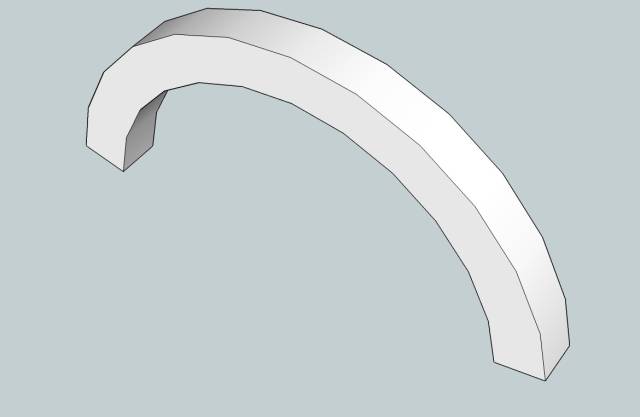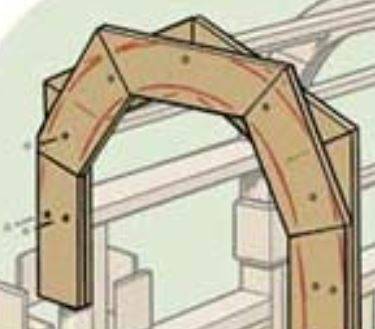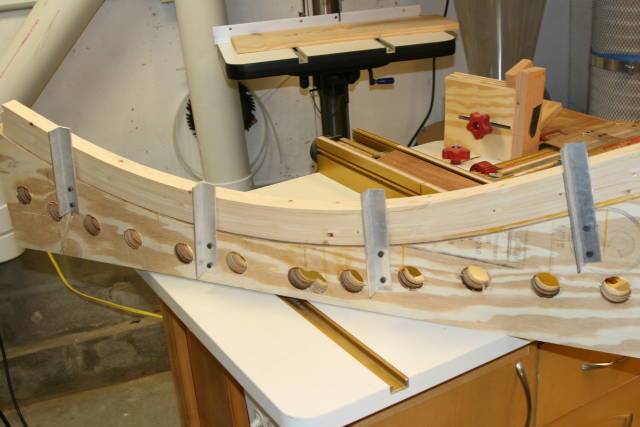
lanwater
in over 11 years
Making a form for an arch
I need to make an arch with a cross section of 3″×3″ for an outdoor table legs using bent lamination
I plan to experiment with 3/16 to 1/4 laminates.
The arch will have about 26" radius since the table will be about 30" high.
for 1/4 " thick laminates I would need 12 of them. Each laminate would be about 90" long.
That’s pi*radius for half a circle: 3.14*26 = 82.
Since I am going to have a stair effect on the ends during lamination I will add another 8" for the ends waste.
All these number are rough number but pretty close to final.

I need to know the best way to make the form so as to minimize the wood needed for the form itself and yet making sure it does not collapse during clamping.
I thought about using plywood or MDF, cut the arches on the bandsaw, stack them about 3.5" high and glue them. That is a lot of waste and probably heavy.
The other way would be out of 2×6 lumber like below. Staking them until I get the right height(3"+)
I need ideas/suggestion please.

Abbas, Castro Valley, CA
17 Replies
Use the same segmented approach with 6" wide strips of mdf. Staggering the joints will add to the strength and stability.
For bent laminations you really do want heavy!
Artisan Woodworks of Texas- www.awwtx.com
I would glue two pieces of 3/4" plywood together bigger that the finished arch. Then draw the inside of the arch. After that glue and screw blocks of wood to the line very 12" say. Then bend your strips around these blocks and clamp.
Tor and Odin are the greatest of gods.
You will develop substantial force with the laminations. I would bite the bullet and make a solid half circle (a little more than half actually) of two layers of plywood with spacer blocks to give you a little over three inch thickness, then cut several holes as required to allow access for clamps. The pieced up mold may work but if it doesn’t, you will find out too late. With a solid mold. You know it won’t move.
The early bird gets the worm but its the second mouse that gets the cheese.
Thanks for the input.
I was afraid I would have to go the Plywood route.
how wide (deep) the spacer between the ply would have to be? Can I get by with 4" deep with glue and screws?
Also, in theory 1/4" laminate should not be a problem for that radius. However, from your experience, will that be a problem when I am pulling 12 of those with the clamps?
Can /should I bend the first few, let the glue set then add some more?
Can I get buy with a ratcheting belt just to pull the laminate and sacrifice it by adding clamps while it’s in place?
Too many questions but I feel your experience is much more valuable than the books here.
Abbas, Castro Valley, CA
I’d go a few at a time both because the force will be more manageable and because a lot of layers with the equivalent of ball bearings in between will make you think of taking up herding cats as an easier alternative.
As for thickness, I would make the mold about 3 1/2" and cut my pieces just less than that. Then I would screw a few sticks on the sides of the mold to control the side slip. You should end up with a little trim room for the inevitable misalignment you will get and still have your 3".
About using a strap….. I think the reel would get too full with the amount of distance you’d have to pull. I haven’t done that but ratchet straps really only work well if you can snug them up empty and only tighten the last bit.
Is that at all clear?
Stack three pieces with glue and put a tack through one end to keep them from sliding lengthwise, then clamp that end and work toward the other.
The early bird gets the worm but its the second mouse that gets the cheese.
Thanks Paul, all clear.
What about the spacer between the 2 ply? it looks like it would have to be 2" thick. I can manage that. How deep would it have to be?
I realize that the laminates will be supported by the 2 ply as well but I am concern that it could give in under clumping pressure and that will translate to the laminates.
Abbas, Castro Valley, CA
Two inches is what you would want, yes. There won’t be a lot of strain on it if you clamp on the plywood itself. A “C” clamp on each side and a stick across the lamination is the way to go. There will be a tendency for the pieces to cup on you so the more clamps the better. This may be a place for some all thread, some wingnuts, and some creative thinking.
The early bird gets the worm but its the second mouse that gets the cheese.
Got it!
Thanks!
Abbas, Castro Valley, CA
I’m using the attached form for my rocker laminations (1 of the rocker arches is shown). To form the arch form, you can use a circle-cutting jig for either the bandsaw (my preference) or via a router.
MJCD

To ensure the arch is properly formed, I have a ‘backer’ laminated arch which sandwiches the 1/4" strips between the form and the pre-formed laminated arch.
I use C clamps and large Bessey clamps to draw-in the lams for gluing.
Thanks MJCD.
I am building one just like yours for a rocking chair based on Hall Taylor plan. That chair is still its infancy. It will probably stay there for a while.
The table leg I need the arch for is 3×3 cross section and 26" in radius. I would have to stack a lot of 2×4 to get the form for that kind of radius.
If I go 4×6 I will need about 9 pieces of 35"-40" long to make the form. I was hopping to minimize $$ and wood waste.
Abbas, Castro Valley, CA
lanwater:
Interesting…, I’m building a Hal Taylor rocker – my first. Well-above my current skillset. I’ve built the templates (as you can see the one, above), finished the seat, the Maloof-style leg joints, and am starting to sculpt the arms and legs. I purchased Hal’s DVD, the Templates, and Book; what I didn’t factor-in is the need for a right-angle grinder, disk sander, router collect extension, and a few other things.
Having said this, it is a Great program; and I’ll be a better woodworker for it.
MJCD
is the router collet extension to carve the seat?
I need to buy yet another rabbet bit for the leg to seat joint.
So far I only made templates and cut the legs rough. I got stuck on making a 2 tones seat. I have not decided on the second "color ".
What I want to do is resaw the seat and add another wood between so when I carve the second color wood will come into view in some area.
This guy has some great dual tone chairs, you probably have seen his work already:
http://canadianwoodworks.com/gallery/rocking-chairs/#.U4fEz6ROW71
Abbas, Castro Valley, CA
No.
I used the Charles Neil approach to carving the seat – very effective, very safe. This approach uses a dado blade in the TS, with a 1/4" thick piece of scrap affixed to the front of the seat (this raises the front, and allows graduated scoop-out depth front-to-back. He then uses an angle grinder to smooth-out the dado results (I used the Kutzall disks, not the Lancelot). The collet extension is for rounding-over the legs’ edges by the joints (not the joints themselves) – the ‘knuckle’ raises the leg about an inch off the router table, and table gets in the way of moving the leg into the bit.
I’ve reviewed several web-based sites for building rockers – Scott Morrison, Hal Taylor has a brief piece on-line, and the Canadian woodworker, as well. Truth is, I saw Hal’s work first, and mentally bought into his approach – He uses a CNC to route his seats (recommends an angle grinder for those without a CNC; Scott Morrison is angle-grinder all-the-way). The Charles Neil approach is effective, safe, and within my skills.
MJCD
I did not know about Charles Neil seat carving approach.
I though about making a saddle that has the same profile and ride a router on top to carve the seat. I will definitely look it up.
Thanks for bringing that up.
Abbas, Castro Valley, CA
lanwater:
I was thinking about your question last night…
There is a YouTube video of an individual using a router to carve the seat-edge profile (using an mdf form) – about 6 months ago, I thought about using this approach, but realized it would result in a 90 degree angle from the seat top not-sculpted to the sculpted area: I wanted a more organic flow to it.
I’ve copied-in the Charles Neil ‘scoopin’ a chair seat’ link.
http://www.youtube.com/watch?v=g6DaDGE_FJI
Cool, Thanks MJCD!
Abbas, Castro Valley, CA











